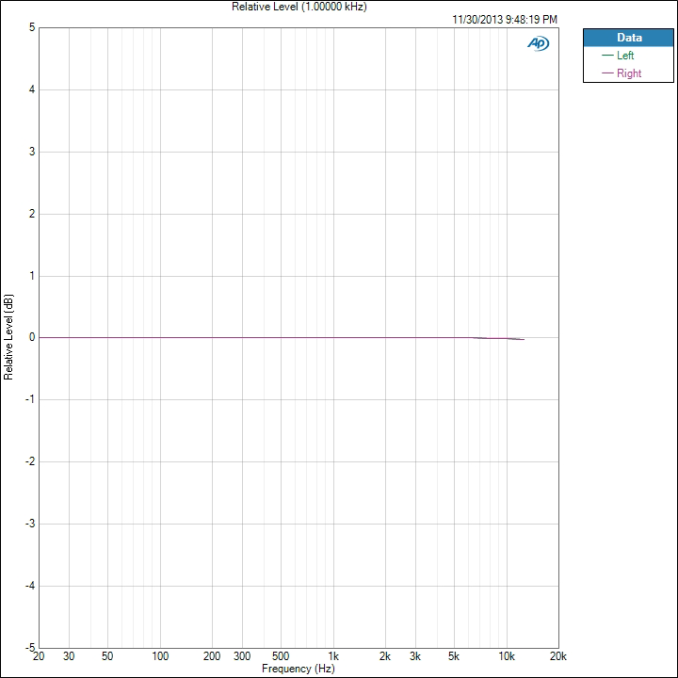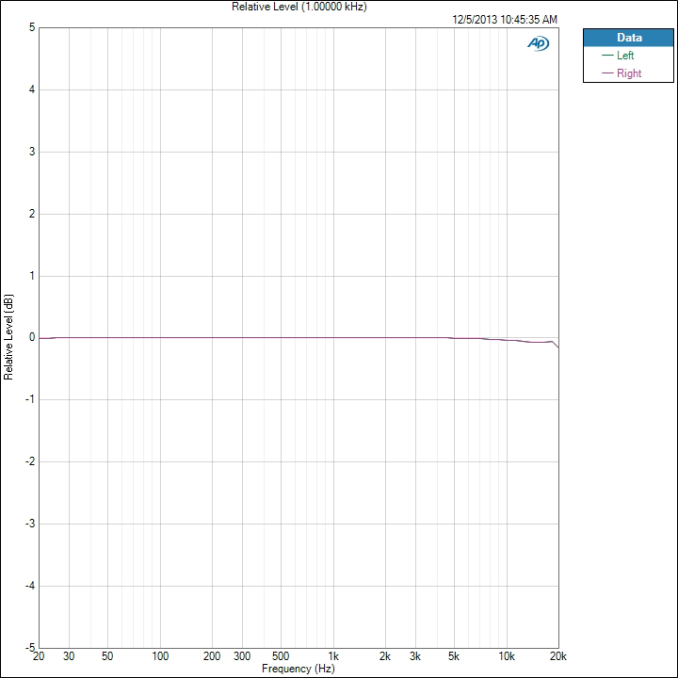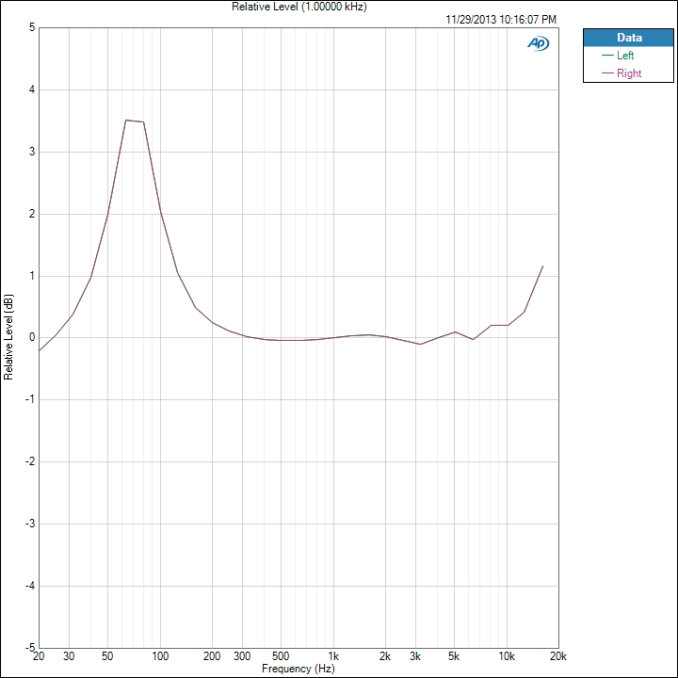Smartphone Audio Quality Testing
by Chris Heinonen on December 8, 2013 5:15 PM EST- Posted in
- Smartphones
- Audio
- Mobile
- Tablets
- Testing
Maximum Level
The maximum output level is derived from the 1kHz test tone used to determine THD+N. The higher the output from the headphone jack, the louder it can drive a pair of headphones. More importantly, having more power available means when you have dynamic music passages that call for power you are less likely to clip the waveform.
There is no chart to show here, just a number that the Audio Precision gives us. In our test data, the most powerful phone was the iPhone 5, at 32.46 mW of power. Next is the Nexus 5 at 22.24 mW, though we can’t drive it that high. Then the Note 3 at 11.81 mW and finally the Galaxy S4 at 3.895 mW. Doubling the power, from 4 mW to 8 mW, produces a 3 dB increase in volume level. 3 dB is the smallest change in volume levels we can easily hear. So even though the iPhone 5 produces 32 mW vs. 4 mW, that is only a 9 dB difference in volume. 10 dB is doubling the volume, so it isn’t even twice as loud. If you have demanding headphones, you will want as much power as you can get.
Frequency Response
To measure the frequency response we measure a set of 61 tones from 20 Hz to 20 kHz. All of these are then equalized to 1 kHz so we can see the maximum deviation from that level. An ideal phone will be perfectly flat here and allow you to adjust this with an EQ setting, or though your taste in headphones. On this test our best performing phone is the Galaxy S4, as seen here.
The total variation from 1 kHz is only 0.014 dB which is very good. The worst performing phone is the iPhone 5, but its variation is only 0.089 dB.
The iPhone 5 also picked up the 20 kHz tone while the Samsung and many others missed it. If we dropped this tone then it might be just as flat. The iPhone 5 test was run slightly differently, as it can't run the Android test program, which might account for this. For a phone with a different response, here is the HTC One with Beats enabled. Other HTC One testing is still in progress as I write this article.
Here we see that Beats is adding a +3.5 dB boost from 60 Hz to 90 Hz, but the deviation from 0 dB goes from 30Hz to 300 Hz. Past 6.5 kHz we also see a rise in the treble. People often mistake boosted treble for extra detail, which is likely the reasoning behind this. As we see it is far different than the other two examples we looked at.













188 Comments
View All Comments
dylan522p - Sunday, December 8, 2013 - link
The One is very interesting in terms of quality. There is a huge difference between the stock music, google play music, power amp, and astro. Astro is the best quality.Impulses - Monday, December 9, 2013 - link
You know, you briefly alluded to the single biggest difference maker and a ton of people would still take it for granted... If you're using crappy headphones much of this is wholly irrelevant. At the same time, expensive headphones aren't always an upgrade... For one thing you've got the Beats and Bose of the world getting by on marketing, and even beyond that not every headphone will be a good match to any given phone depending on how hard to drive it is (or isn't) and how out of whack the phone's output impedance is (something that's often taken for granted even with dedicated audio components).Daniel Egger - Sunday, December 8, 2013 - link
I always thought the reference for audio testing equipment, especially in telecommunications, was HEAD acoustics. Still a good and interesting article.Drumsticks - Sunday, December 8, 2013 - link
Jeez Anandtech rocks. Thanks guys!RoninX - Sunday, December 8, 2013 - link
Great! This is exactly what I've been waiting for.I've noticed the audio quality on my Droid 4 is sufficiently poor that I continue to carry around an iPod Classic along with the D4. I'm hoping that the sound quality on my next phone, likely either a Note 3 or the next gen HTC One (One Two?), will be good enough that this isn't necessary.
pukemon1976 - Sunday, December 8, 2013 - link
2 thumbs up for galaxy note 3 audio quality. was quite surprised.dylan522p - Sunday, December 8, 2013 - link
One definely. The internal amp adds tons to quality the Two or whatever it is called will assuradly be even better.quick brown fox - Sunday, December 8, 2013 - link
As a mild audiophile who occasionally searches for electrical measurements of DAPs/smartphones on IF/GE/GSMA/Voldemort's Blog/etc, I am very pleased seeing this article in Anandtech! Had a mild laugh seeing the HTC One 'Beats Enabled' frequency response (is the treble peak still there without Beats?), and I'm very much looking forward to seeing some Nvidia Shield/SIII i9300 measurements.cheinonen - Sunday, December 8, 2013 - link
With Beats disabled, you actually see a bit of a roll-off in the bass and the treble. It's +/- 0.230 dB so not a level you'll likely hear. Overall the response is very flat if you turn off Beats. I'm still testing something else I found with the HTC One before I have full numbers up there.quick brown fox - Sunday, December 8, 2013 - link
Thanks. Again, this article is excellent; looking forward for more measurements!